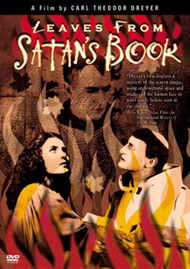| Release List | Reviews | Price Search | Shop | Newsletter | Forum | DVD Giveaways | Blu-Ray/ HD DVD | Advertise |
| Reviews & Columns |
|
Reviews DVD TV on DVD Blu-ray International DVDs Theatrical Reviews by Studio Video Games Features Collector Series DVDs Easter Egg Database Interviews DVD Talk TV DVD Talk Radio Feature Articles Columns Anime Talk DVD Savant HD Talk Horror DVDs Silent DVD
|
DVD Talk Forum |
|
|
| Resources |
|
DVD Price Search Customer Service #'s RCE Info Links |
|
Columns
|
 |
Leaves from Satan's Book
|
||||
Leaves from Satan's Book is an interesting concept said to be inspired by D.W. Griffith's Intolerance; according to the package text, Griffith returned the gesture by doing his own version of the same Marie Correlli book, The Sorrows of Satan, a few years later. Dreyer is apparently just getting his cinema craft together and is more concerned with accurate historical reconstruction than with presenting the tale in anything more than standard closeup - wide tableau silent style. Some framings are dynamic (the priest whipping himself at the cross, Marie Antoinette appearing in her white dress for the executioner) but most of the visuals are content to show off the convincing sets and costumes for the four stories. The story foundation is fairly flimsy, with some author's conceits added to known bible lore. Satan isn't just cast from heaven, he's been given a regular contract with his almighty father that includes specifics on souls lost and found, and how many years Satan can get off for good behavior if his victims resist him and stay faithful to their vows to God. As it encourages Satan to do a poor job, this is truly a strange bargain: The more souls that slip through Satan's claws, the sooner he'll be back by God's side. Frankly, Peter Cook and Dudley Moore's devilish bargain in Bedazzled makes a lot more sense. Satan appears in very specific human form to tempt very specific human targets, an arrangement that makes his job seem rather difficult, unless he can duplicate himself to simultaneously tempt millions of sinners around the world at the same time. Also, his personal involvement in the betrayal of Christ seemingly takes much of the guilt away from Judas and those scheming priests, unless we're to take this account as some kind of parable. At one point, Satan even identifies himself to one of his dupes, after the damage has been done. Three out of four stories have restrained sex themes. A priest can be tempted because he's already compromised his faith by lusting after a Spanish beauty, and the film shows him flagellating himself and seeing a hallucination of the woman lying at the foot of a cross. The Grand Inquisitor (Satan) allows the priest to spend the night with her, as they're trying to save her soul and her body 'does not matter.' Not quite Ken Russell, but pretty wild stuff for 1920. The French Revolution story shows an ex-servant citizen trying his best to save two fugitive royal women, only to be tricked repeatedly by the political agent (Satan again). In the contemporary story, the plight of the family is a pale imitation of Griffith. The wife is faithful to the White (non- Communist) cause because it presumably is on God's side, and stays faithful even though the Reds are going to execute her husband and children. Not realizing they're being saved, she kills herself, which is supposed to prove how virtuous she is. It's implied that she's also avoiding rape - a sex-crazed man has started all the trouble in this episode as well. Forgive my ignorance, but it is my understanding that suicide is a mortal sin in every Christian sect. She has completely defied Satan's temptations, yet by killing herself, surrenders her soul to him. A rather long film, Leaves from Satan's Book is difficult to assess from our position 85 years later. It impresses with its production values and overall seriousness but is not essential viewing; instead, we simply see a Carl Dreyer movie made before he developed his personal stamp. Image/Blackhawk's DVD of Leaves from Satan's Book is a good transfer of an intact surviving element that is on the contrasty side, with some serious scratches and gate lift on splices. The tinting is nicely done. The show begins with an original Nordisk Films polar bear logo even though the rest of the titles are later replacements. Philip Carli's keyboard score is adequate to good, using La Marseilles during the French Revolution section, as cued by an intertitle. The intertitles also identify all the actors by name, making it easy for the IMDB to keep straight who played who!
On a scale of Excellent, Good, Fair, and Poor,
Leaves from Satan's Book rates:
Review Staff | About DVD Talk | Newsletter Subscribe | Join DVD Talk Forum |
|
| Release List | Reviews | Price Search | Shop | SUBSCRIBE | Forum | DVD Giveaways | Blu-Ray/ HD DVD | Advertise |






